Utah County Birders Newsletter
|
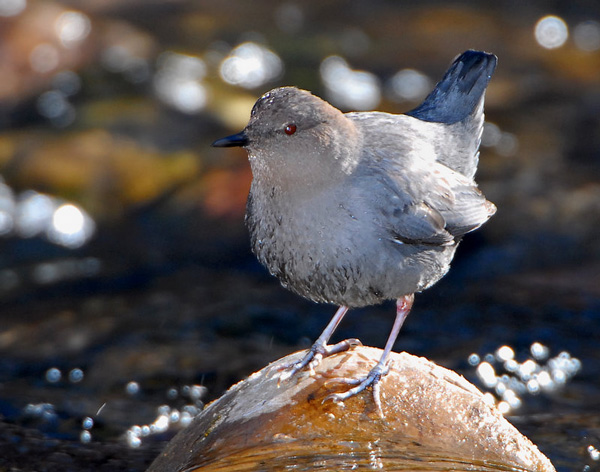 |
|
American Dipper - photo by Paul Higgins |
Bird of the Month
The American Dipper
Cinclus mexicanus
by Landon Jones
Last week I went to a lovely picnic at South Fork Canyon Park with my good
friend and his family. He just finished law school and got a good job with a law
firm, and I hadn’t seen him for a year of so. After discussing his work a little
he asked me if there were any strange or interesting birds in Utah. Pointing to
the stream running through the park, I told him about one of the most amazing
and specialized birds in the U.S., the American Dipper.
The American Dipper, Cinclus mexicanus, frequents fast-flowing mountain steams
and rivers year-round. It obtains food by diving under water, walking upstream
against the current, and turning over rocks and searching along the bottom for
tasty invertebrates. “What???!!!” I said in my mind, the first time I heard
this. “Surely I must have heard incorrectly.” No, you heard it right. “It walks
underwater, not swims, in mountain streams created from snowmelt, even in the
winter, and eats bugs off the bottom?” Yes. “That’s crazy! How can it do
that??!!” Dippers sport some fascinating adaptations for their frigid aquatic
lifestyle.
Most aquatic birds are fairly large, so as to conserve as much body heat as
possible, but dippers are rather small at about seven and a half inches in
length. Larger animals retain more heat as they increase in size because their
volume increases little as mass increases, leaving less surface area for heat to
dissipate away from them, keeping them warmer. Dippers also have little in the
way of fat reserves compared to other aquatic birds. They do, however, have lots
of down feathers, to keep them warm while diving, which is quite a divergence
from the typical passerine body plan. Dippers also have an enormously enlarged
preen gland (ten times the size of other passerines), which allows them to
waterproof their numerous feathers. Water just rolls off them as they come up
for air after a dive. Also related to thermoregulation, dippers have very short
tails and wings compared to other passerines. Long tails and wings would quickly
dissipate much of the heat necessary to keep them warm. Their body plan is as
close to a sphere as possible, the most efficient shape for heat conservation,
without compromising other morphological traits necessary for life in their
habitat. Dippers can survive winter temperatures as low as -49° F.
Dippers are also well-adapted to their unique environment. The first time I saw
an American Dipper, I thought it was a rock on a sandbar in the middle of the
river until it moved and sang its clear notes. Their plumage blends well with
their surrounding habitat. Logically, dippers would do well in the water with
webbed feet, but as passerines, their feet are fixed in the typical passerine
toe configuration, which constrains the development of this trait. However,
dippers have strong legs and well-developed claws, allowing them to forage on
the stream bottom under continuous pressure against the fast-moving current.
Their chest muscles are also very strong compared to other passerines so they
can flap their wings underwater, their primary means of locomotion in their
habitat. They also have a third eyelid, which is clear and protects their vision
underwater (built in goggles, wouldn’t that be handy!). They also have movable
flaps to cover their nostrils when diving (and noseplugs too!).
American Dippers defend linear stretches of streams as their individual
territory, year-round. One of their most interesting attributes that they share
with no other bird outside their family is a feathered eyelid. The eyelid is
white and conspicuous against their drab gray plumage, warning other dippers to
stay out of their territory. This adaptation allows them to stay relatively
incognito from predators most of the time, but the flash of white is
unmistakable when they want to be noticed.
Dippers are in the family Cinclidae, and all are in the genus Cinclus. There are
only five species in the world, almost one for every major continent. The
American Dipper (Cinclus mexicanus) resides in western North America, from
Alaska to Panama. The Rufous-throated Dipper (Cinclus shulzii) occurs in South
America along with the White-capped Dipper (Cinclus leucocephalus) which is
confined mostly to the Andes mountain range. The White-breasted Dipper (Cinclus
cinclus) is distributed throughout Europe and into a little bit of North Africa.
The Brown Dipper (Cinclus pallasii) is found throughout Asia. Dippers are
currently placed as most closely related to thrushes. However, their unique
adaptations to take advantage of a very harsh and specialized feeding niche make
them, in my eyes, birds nothing short of miraculous. When I ask birders from the
east coast what species they would like to see in Utah, they often say “show me
one of those dippers.” The concept of an American Dipper is simply unreal until
you have seen one; they are truly one of the marvels of the west.
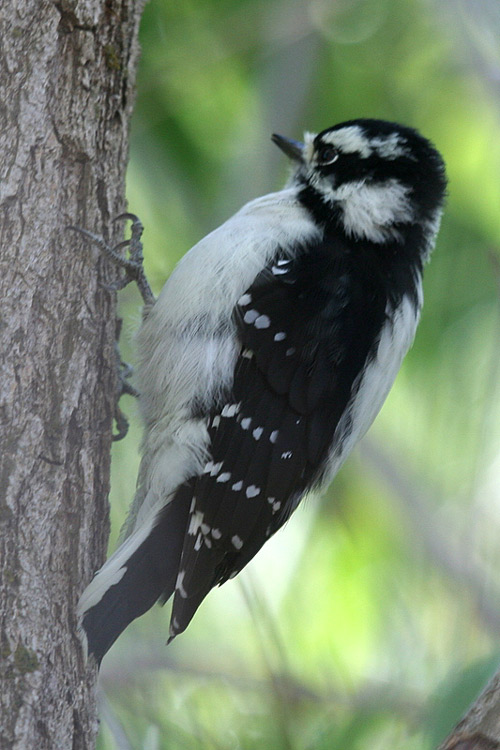 |
|
Downy Woodpecker - September 3, 2008 - photo by Cheryl Peterson |
River Lane - 3 September 2008
by Cheryl Peterson
Bonnie Williams, Eric Huish and Cheryl Peterson birded River Lane in hopes of
finding migrants, especially warblers. While we enjoyed the birds we saw, it was
disappointing that we didn’t see as many birds as we had in previous years.
We saw 5 warblers: Orange-crowned, Nashville, Yellow, Yellow-rumped and
Wilson’s. Two Wood Ducks on the Spanish Fork River were a nice find. There were
also at least 5 Downy Woodpeckers. Other bird that we saw or heard: Canada
Goose, Ring-necked Pheasant, Sandhill Crane, Caspian Tern, Mourning Dove, Common
Nighthawk, Western Wood-Pewee, Plumbeous Vireo, Warbling Vireo, Black-billed
Magpie, Northern Rough-winged Swallow, Black-capped Chickadee, House Wren,
Blue-gray Gnatcatcher, American Robin, Gray Catbird, European Starling, Chipping
Sparrow, Vesper Sparrow, Song Sparrow, Blue Grosbeak, Yellow-headed Blackbird
and American Goldfinch.
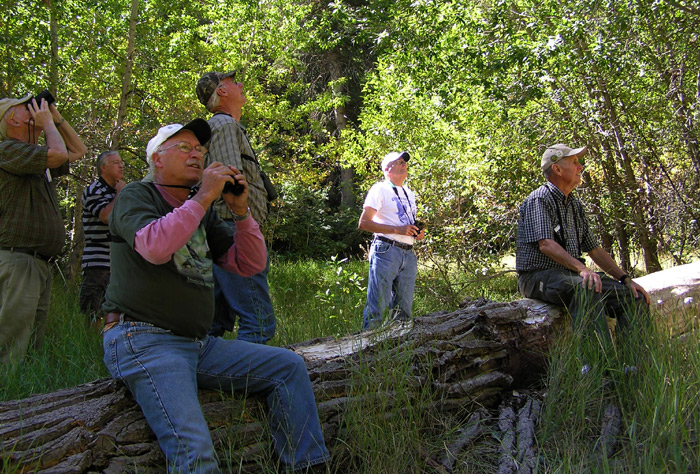 |
|
Utah County Birders in Maple Canyon - September 6, 2008 - photo by Eric Huish |
Sanpete County - 6 September 2008
by Yvonne Carter
In attendance on this field trip was Lu Giddings our leader, with Steve Carr,
Merrill Webb, Bart and Yvonne Carter, Ned Bixler, Eric Huish, and Joe Marty.
Seven great guys and one woman. Hey Gals! Where were you?
Leaving the Springville Walmart parking lot and heading south to Nephi on the
I-5, we headed east out of Nephi on Highway 132 to Sanpete County. Turning off
to the right into the farm lands west of the main highway, we birded along the
way to the Fountain Green Fish Hatchery. And then further south through the town
of Fountain Green, Freedom and Wales to the Wales Reservoir. Doubling back we
went up Maple Canyon which is west of Freedom (look for the Freedom cemetery
sign).
We observed Canadian Geese, Gadwall, Mallard, Northern Shoveler, Northern
Pintail, Green-winged Teal, Eared Grebe, American White Pelican, Great Blue
Heron, White-faced Ibis, Turkey Vultures, Northern Harrier, Swainson's Hawks,
Red-tailed Hawks, Golden Eagle, American Kestrel, Prairie Falcon, American Coot,
Sandhill Crane, Black-bellied Plover, Killdeer, Black-necked Stilt, American
Avocet, Greater Yellowlegs, Marbled Godwit, Baird's Sandpiper, Wilson's
Phalarope, Ring-billed Gull, Eurasian Collared-Dove, Mourning Dove, Say's
Phoebe, Western Kingbird, Plumbeous Vireo, Warbling Vireo, Stellar's Jay,
Black-bellied Magpie, Common Raven, Horned Lark, Tree Swallow, Violet-Green
Swallow, Northern Rough-winged Swallow, Barn Swallow, Black-capped Chickadee,
Mountain Chickadee, Red-breasted Nuthatch, Mountain Bluebird, Robin, Sage
Thrasher, Starlings, Western Tanager, Green-tailed Towhee, Brewer's Sparrow,
Lark Sparrow, Savannah Sparrow, Lazuli Bunting, Western Meadowlark, Brewer's
Blackbirds, House Finch, Pine Siskin, Lesser Goldfinch, American Goldfinch, and
House Sparrow.
We had great weather, perfect temperatures and a good number of birds as you can
see. A good time had by all!
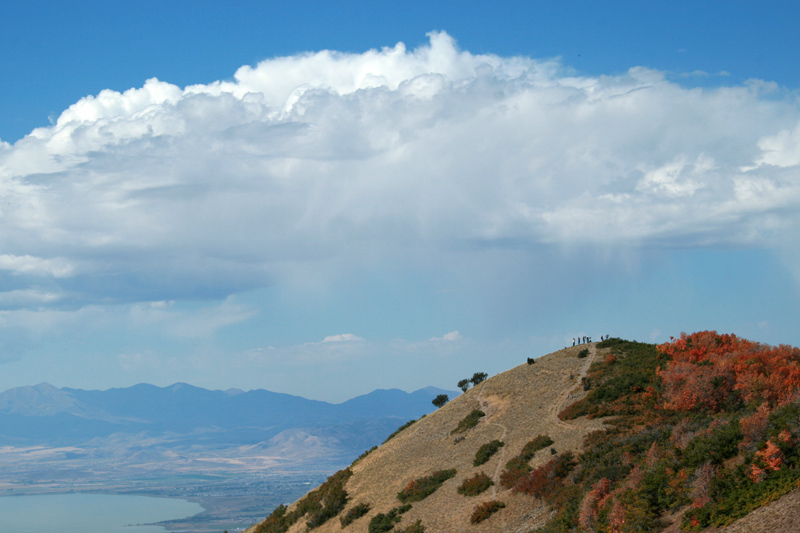 |
|
Utah County Birds atop Hawk Knoll - September 27, 2008 - photo by Keeli Marvel |
Squaw Peak Road - Hawk Watching - 27 Sept 2008
by Eric Huish
Utah County Birders met at the Orem 8th North Park-and-Ride at 9:00 a.m. On our
way to the Squaw Peak Overlook we stopped at Canyon View Park and Hope
Campground. At Canyon View Park, in Provo Canyon, we saw nothing. I think I
heard a Magpie. We walked the loop at Hope Campground where there were a few
Yellow-rumped Warblers and lots of campers.
The birding was slow so we went out to watch hawks which was the main purpose of
the field trip. We stopped at the DWR Raptor Watch Day at the Squaw Peak
Overlook. They had seen a flock of Pinyon Jays fly past about an hour before we
got there. We didn't stay long at the DWR Raptor Watch Day. We headed to the
hilltop above the parking area. We could see the crowds that came to the raptor
watch throughout the day. It looked like it was a popular event.
We watched for hawks for several hours from our hilltop. We were hoping for a
Broad-winged Hawk. Didn't see one. I checked birdnet when I got home and saw
that there were a few Broad-wings seen by hawk watchers in the Wellsville
mountains. I guess the Wellsvilles were the place
to be that day. We did see many Sharp-shinned, Cooper's and Red-tailed Hawks,
some Golden Eagles, a couple Kestrels, a Merlin and three Turkey Vultures. There
were Wild Turkey in the area. A few turkeys flew off the hillside near us and
into the oaks. We also had Mountain Bluebirds land in a nearby tree for good
viewing. The scenery was awesome.
Utah Ornithological Society Conference
Report
12-14 September 2008
by Eric Huish
The Utah Ornithological Society's Annual conference is always a great event.
With field trips, paper presentations on a variety of bird related subjects and
an evening social with a keynote speaker, the conference is a great place to
learn more about birds. This year's conference was held in Ogden at Weber State
University and hosted by the Wasatch Audubon Society.
Friday Field Trips
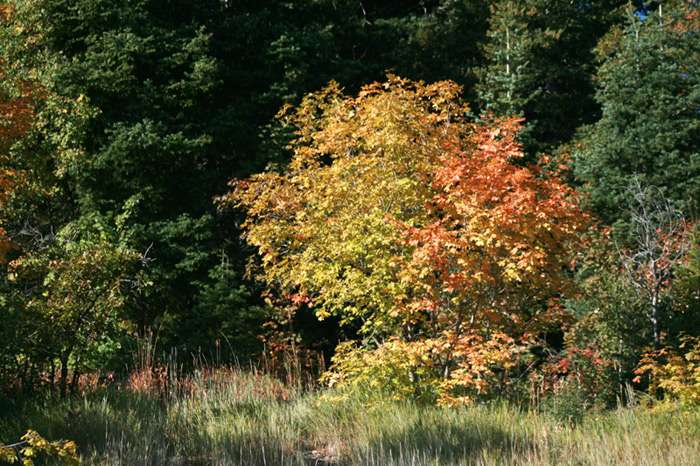 |
|
Fall Maples at Maple Campground - September 12, 2008 - photo by Keeli Marvel |
Snowbasin
I went on the Snowbasin field trip led by Les Talbot. We reached snowbasin at
8:45 a.m. and walked the trail out to the Maples C.G. It was a beautiful crisp
mountain morning. We could hear Clark's Nutcrackers up on the mountainside and a
Red-breasted Nuthatch off in the forest somewhere. Down the trail we came across
a group of young Juncos. The birding was kind of slow until we came across a
small flock of birds at the campground that included Yellow-rumped, Wilson's and
Townsend's Warblers, Black-capped Chickadees and a Downy Woodpecker. On our way
back to the car we got a good look at a Sharp-shinned Hawk and found a few
Red-breasted Nuthatches and a Cassin's Vireo in a pine tree. The Cassin's Vireo
was a lifer for a couple people in the group.
We made a stop at Middle Fork WMA. There were very few birds here. Best
bird was an American Kestrel.
Our last stop was at the North Arm Natural Area. Here we had Turkey Vultures,
Red-tailed Hawks and a Swainson's Hawk soaring overhead. Along the trail we saw
Orange-crowned Warblers, another Townsend's Warbler along with a few other
passerines.
Bear River Refuge
Conference attendees met at the Bear River Refuge visitor's center at 8:30 a.m.
for a tour of the closed-to-the-public D line of the refuge led by Betsy Beneke.
I didn't go on this trip but the response I got most when asking people about it
was "lots of brown Ducks". Their best birds were a few Great Egrets and a
Solitary Sandpiper. They also saw the 'regulars' one would expect on a tour of
the refuge. Tuula Rose told me about one of her favorite sights of the day;
several Turkey Vultures on fence posts (closer than she had ever seen before) on
both sides of the vehicle as they drove through the fields to the D line of the
refuge.
Rainbow/Birdsong Trail
This trip was led by Mort and Carolyn Somer. I didn't hear how this trip went.
All I heard is that due to the wind they ended up at the Cemetery. I'm sure they
got some good birds.
Friday Evening Social
Several UOS members met at Jeremiah's Restaurant for an evening social with hors
d'oeuvres, beverages and a keynote speaker. Dr. Dale Clayton, Professor of
Biology at the University of Utah, spoke to us about feather lice and other bird
parasites. It was a very fascinating presentation. I know you think I'm just
saying that, but it was fascinating! Ask anyone who was there.
Saturday Bird Walk and Paper Session
Beus Park
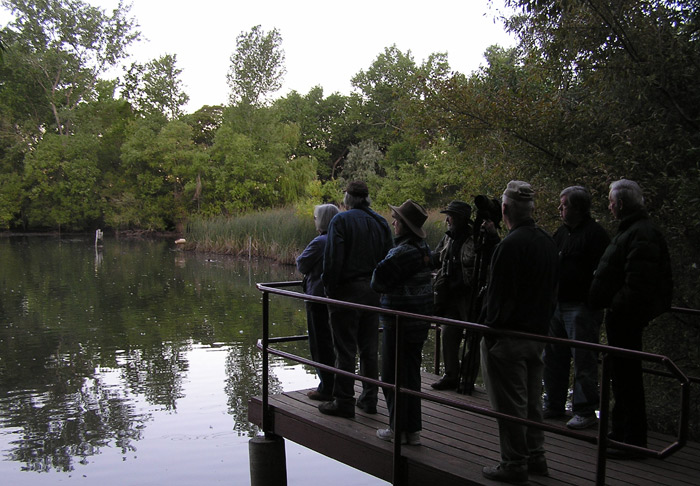 |
|
Birding Beus Park - September 13, 2008 - photo by Eric Huish |
Jack Rensel led a bird walk around Beus Park early Saturday before the paper
session started. Jack informed us of the history of the park and how the Wood
Ducks got there. As we were walking around the pond a couple of large objects came
crashing down from the tops of the trees to the forest floor. Beus Pond is a
small pond surrounded by tall trees. Two Canada Geese had hit the
treetops as they were coming in for a landing and fallen straight down through
the trees. We watched a Goose walking through the forest towards the pond.
The goose seemed okay. It was a comical sight.
There were many birds around that morning. Downy Woodpecker, Western Wood-pewee, Plumbeous Vireo, Western Scrub-Jay, Black-billed Magpie, Black-capped Chickadees, Red-breasted Nuthatch, American Robins, Townsend's Warbler, Wilson's Warblers, Western Tanagers, Song Sparrows, House Finches and up-close beautiful views of a Black-crowned Night-Heron. Very good for a short early morning walk.
After the bird walk we headed to the Shepherd Union Building at WSU for a
continental breakfast and paper presentations by graduate students and
researchers on a variety of subjects. The paper session is always the most
interesting part of the UOS Conference. We had breaks during the day when the
attendees could socialize. I enjoyed meeting people I only know from posts on
the listserv and birders I don't see very often.
Sunday Field Trip
North Arm Natural Area
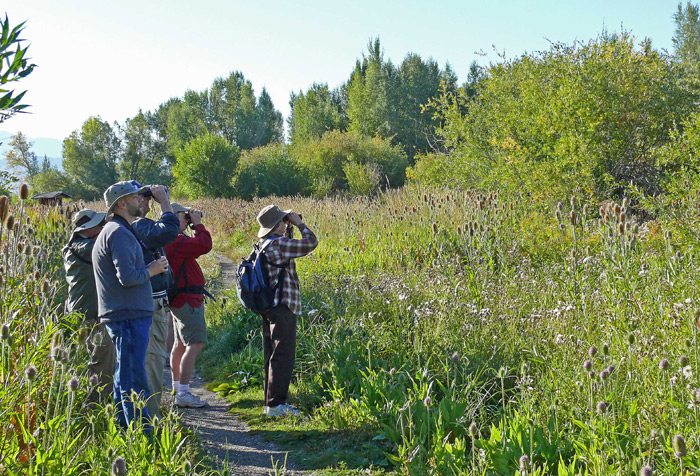 |
|
Birding North Arm Natural Area - September 14, 2008 - photo by Keith Evans |
There were two field trip choices on Sunday, meeting at the same place and time.
Seven people showed up. Since it was not a large group, we decided not to split up.
Kristin Purdy led us to the North Arm Natural Area then to Jefferson Hunt
Campground. The North Arm was full of birds. Across the field from the parking
area was a tree full of Turkey Vultures (15) and a pair of Sandhill Cranes
flew in as we started down the trail. There was so much bird activity it took us
45 minutes to walk the short distance from the parking area to the first bridge
over the stream. At the bridge the birds were still thick enough to keep us
planted in one spot. Between the parking lot and the bridge we heard a
'Solitary' Vireo and saw a Downy Woodpecker, Warbling Vireo, Black-capped
Chickadees, American Robins, Cedar Waxwings, Orange-crowned Warblers, Virginia's
Warbler, Yellow Warbler, Yellow-rumped Warblers, MacGillivray's Warbler, Common
Yellowthroat, Wilson's Warblers, many Chipping Sparrows, Song Sparrow,
White-crowned Sparrows, Lazuli Buntings, Red-winged Blackbird, House Finch,
Lesser Goldfinch and American Goldfinch.
We eventually broke ourselves away from the bridge and walked the trail through
the thick vegetation, then up along the hillside where we could get a view of
the area from
above. Along here we were able to find Northern Flicker, Dusky Flycatcher,
Red-breasted Nuthatch (heard only), Blue-gray Gnatcatcher, Gray Catbird, Spotted
Towhee, Fox Sparrow and Lincoln's Sparrow. On our way out we heard and, after a
second of searching, saw a pair of Pinyon Jays flying over. It was an unexpected
sighting for this area. Other birds seen in the North arm area included Canada
Goose, Black-billed Magpie, Sharp-shinned Hawk and Swainson's Hawk.
At Jefferson Hunt Campground we walked a trail out to a spot where we could overlook a
distant Pineview Reservoir. We saw 17 species. Osprey, Red-tailed Hawk, Belted
Kingfisher and Western Wood-Pewee were added to our day list.
It was a great weekend.
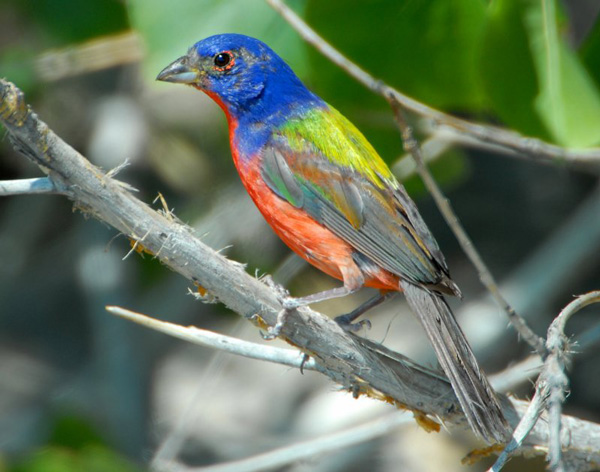 |
|
Painted Bunting - photo by Paul Higgins |
by Milt Moody
With the addition of four new species so far in 2008 the number of officially
documented species seen in Utah is a whooping 440. That makes 14 new species
added since the publication of the official state checklist by the Utah Bird
Records Committee in 2004, and there may be more to come.
The four new species added so far this year are the Painted Bunting that
showed up at Fish Springs in the west desert, Cape May Warbler seen at
Red Cliffs Golf Course in St. George, Sharp-tailed Sandpiper at the
Antelope Island Causeway and a Pine Warbler discovered at Lytle Ranch in
southwestern Utah. And there may be more coming before the year is out. Right
now there are six sight record for new Utah species under review by the Records
Committee. Several of them look like they may have a pretty a good chance to be
accepted increasing our state list by several more. A record for a
Whip-poor-will is looking very good (or should I say sounding very good
since the main documentation is from sound recording) and a well documented
Purple Finch record is looking very promising as well. (Several previous
Purple Finch sightings have been submitted but have not had sufficient
documentation to be accepted until maybe this one). Other possibilities are
Gilded Flicker and Baird’s Sparrow records which are in the second
round of reviews, which indicates that there were significant questions in the
first round on these records. Records for Mississippi Kite and
Mountain Quail are still in their first round so a possible new Utah species
may come from one of these records as well. (These records can be found and
perused on the Records Committee pages of the utahbirds.org website).
The 1998 checklist for Utah listed 406 species. About 10 years later, 34 new
species have been added. It looks like the increased number of birders, better
communication, more easy-to-carry digital cameras producing easy-to-share
pictures have contributed to this boom in new birds for our state. How many more
species could we see in Utah? Well, if the following list of “unconfirmed
species” is any indication, we’re not done yet.
Sixteen species that have been reported in Utah but not confirm: Tufted
Duck, Leach's Storm-Petrel, White-tailed Hawk, Bar-tailed Godwit, Laughing Gull,
Black-tailed Gull, Iceland Gull, Parakeet Auklet, Blue-throated Hummingbird,
Pileated Woodpecker, Pacific-slope Flycatcher, Sprague's Pipit, Blackburnian
Warbler, Mourning Warbler, Olive Warbler, and Varied Bunting.
Backyard Bird of the
Month
September 2008
Steve Carr - Holladay
Little Corella - My new backyard in Australia. Actually, an escaped cage
bird of the Cockatoo family.
Yvonne Carter - Highland
The chickadees are taking over the finch feeders.
Lynn Garner - Provo
Western Scrub-Jays returning to my platform feeder.
Eric Huish - Pleasant Grove
Orange-crowned Warbler - skulking in the bushes.
Milt Moody - Provo
California Quail - wandering pretty friendly herds.
Cheryl Peterson - Provo
Calliope Hummingbird
Bruce Robinson - West Jordan
Western Wood-Pewee - Another sign of fall (dangit!)
Tuula Rose - Provo
A female Wilson's Warbler busy in the bushes, occasionally flitting over
to the grass catching little moths.
Reed Stone - Provo
Western Scrub-Jay - The only time I see Scrub-Jays in the yard is when
the Oak tree is full of acorns.
Bonnie Williams - Mapleton
Ring-necked Pheasant - he stays around here all year.
We would like you to share your favorite backyard bird each month. Please send
your favorite bird at the end of the month to newsletter@utahbirds.org or call
360-8777.